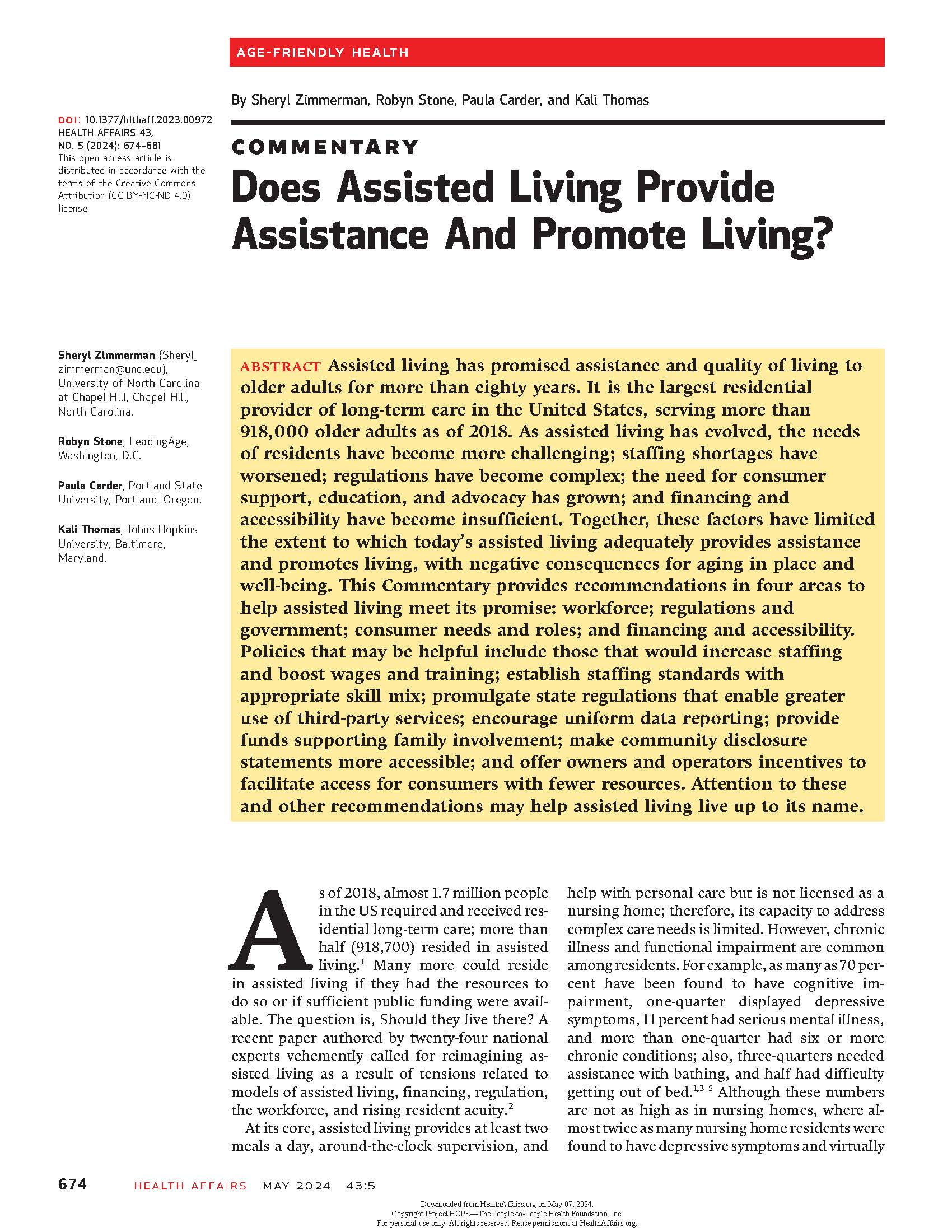WHAT THIS MEANS FOR YOU: Using Medicare data for over 430,000 assisted living and long-stay nursing home residents, prescriptions for antipsychotic drugs decreased in both settings from 2010-2012 (before the National Partnership to Improve Dementia Care in Nursing Homes) to 2012-2017 (post-Partnership). However, assisted living prescribing decreased at a slower rate than nursing homes, meaning that the Partnership likely did not have a measurable impact in assisted living.
Cognitive/Dementia
Injury-Related Emergency Department Use among Assisted Living Residents with Alzheimer’s Disease and Related Dementias
Injury-Related Emergency Department Use among Assisted Living Residents with Alzheimer’s Disease and Related Dementias
WHAT THIS MEANS FOR YOU: Using 2018 Medicare data for over 116,000 residents, residents with dementia had a 25% higher risk of going to the emergency room for injuries compared to those without dementia, as well as having a significantly higher chance of being hospitalized for injuries, regardless of whether they lived in general assisted living or memory care.
Excess Mortality Among Assisted Living Residents with Dementia during the COVID-19 Pandemic
Excess Mortality Among Assisted Living Residents with Dementia during the COVID-19 Pandemic
WHAT THIS MEANS FOR YOU: Data from over 560,000 Medicare recipients revealed that residents with dementia experienced 33.4 more excess deaths per 100,000 compared to those without dementia during the COVID-19 pandemic. Residents in memory care communities did not have significantly different mortality rates compared to those in general assisted living settings.
Successful Aging in Assisted Living: The Importance of Near Visual Acuity
Successful Aging in Assisted Living: The Importance of Near Visual Acuity
Successful aging among independent community-dwelling older adults and those in residential settings is paramount to aging in place. The purpose of the current study was to explore how sensory, cognitive, and functional impairments affect successful aging in assisted living (AL) settings. Vision compromise was noted for near visual acuity (NVA) (14.3%) and distance visual acuity […]
The Impact of FFC-AL-EIT-D in Assisted Living during the COVID-19 Pandemic
The Impact of FFC-AL-EIT-D in Assisted Living during the COVID-19 Pandemic
WHAT THIS MEANS FOR YOU: Function Focused Care was tested in 51 assisted living communities in one state during the COVID-19 pandemic. Although there was no change in resident falls, emergency room visits, hospitalizations, or transfers to nursing homes, organizational policies and environments supporting physical activity for residents improved.
Dementia and COVID-19 Infection Control in Assisted Living in Seven States
Dementia and COVID-19 Infection Control in Assisted Living in Seven States
WHAT THIS MEANS FOR YOU: The study examined how 119 assisted living administrators in 7 states implemented COVID-19 infection control practices from July 2020 to September 2021, including the feasibility of select infection control practices. Results indicated that although there were infection control challenges across all community types, dementia-specific communities faced the most difficulties. Less than half of administrators found it feasible to close indoor common areas, and residents, especially in dementia-specific communities, were less likely to wear masks and -wearing and physical distancing.
Assisted Living Residents With Dementia: Being Out in the World and Negotiating Connections
Assisted Living Residents With Dementia: Being Out in the World and Negotiating Connections
WHAT THIS MEANS FOR YOU: This year-long study observed 33 individuals and their caregivers in 4 assisted living communities, focusing on the significance of outdoor and offsite activities for persons living with dementia. Data included 1,560 observation hours, 114 interviews with residents, staff, family, and visitors, and resident record reviews. Qualitative findings suggested that engaging with others and with nature is important for better quality of life. Most residents were able to at least occasionally go out, and those who went outdoors generally had positive experiences, but not all experiences were positive.
Staff Reports of Behavioral Expressions of Persons with Dementia in 250 Assisted Living Communities
Staff Reports of Behavioral Expressions of Persons with Dementia in 250 Assisted Living Communities
WHAT THIS MEANS FOR YOU: This study included health care supervisors from 250 assisted living communities in 7 states to understand how staff respond to behavioral expressions of residents with dementia. The most commonly reported expressions were combativeness and anxiety. A thematic analysis found that in about 25% of cases, staff recognized the events preceding behavioral expressions (antecedents). Staff in smaller and memory-care only communities were more adept at identifying antecedents; additional training to anticipate expressions may help prevent them.
Potential Side Effects and Adverse Events of Antipsychotic Use for Residents With Dementia in Assisted Living: Implications for Prescribers, Staff, and Families
Potential Side Effects and Adverse Events of Antipsychotic Use for Residents With Dementia in Assisted Living: Implications for Prescribers, Staff, and Families
WHAT THIS MEANS FOR YOU: This study examined the use of antipsychotic medications among residents with dementia in 91 AL communities across seven states. The prevalence of potential side effects was high (93%) and of possible adverse events low, (6%), potentially associated with medication side effects. Quetiapine (Seroquel) and risperidone (Risperdal) were the most frequently prescribed antipsychotics. Most, but not all, residents’ family members were aware of their relative’s antipsychotic use.
The Impact of Cognitive Impairment on Clinical Symptoms, Physical Activity and Care Interactions among Residents in Assisted Living Settings
The Impact of Cognitive Impairment on Clinical Symptoms, Physical Activity and Care Interactions among Residents in Assisted Living Settings
WHAT THIS MEANS FOR YOU: This study included 550 AL residents from 59 communities, and assessed how cognitive impairment relates to physical activity, pain, and willingness to receive staff-assisted function-focused care. It found that cognitively impaired residents were less active, experienced more pain, and were less interested in staff-assisted function-focused care activities.
“Uncivilized Children” or “Victims of Dementia”: Interpretations of Aggression in Older Assisted Living Tenants
“Uncivilized Children” or “Victims of Dementia”: Interpretations of Aggression in Older Assisted Living Tenants
WHAT THIS MEANS FOR YOU: Researchers interviewed 13 AL residents and 19 care workers in two communities about resident aggression. Care workers reported physical and verbal aggression, while residents reported relational and sexual aggression from peers. Both groups often attributed aggression to communal living, aging, or dementia, suggesting that they normalized the behavior and often did not report it. Underreporting of resident aggression was more common for workers than residents.
Memory Care Reduces Nursing Home Admissions among Assisted-Living Residents with Dementia
Memory Care Reduces Nursing Home Admissions among Assisted-Living Residents with Dementia
WHAT THIS MEANS FOR YOU: Medicare data for over 20,600 assisted living residents with Alzheimer’s disease and related dementias (ADRD) indicate that residents of memory care had a significantly lower risk of hospitalization, nursing home admission, and long-term nursing home stays compared to those in general communities.


